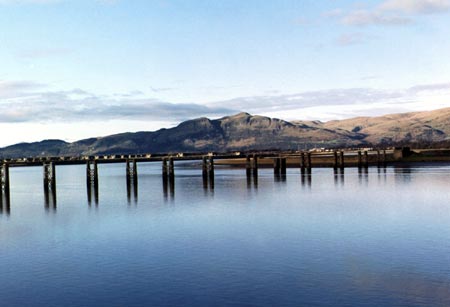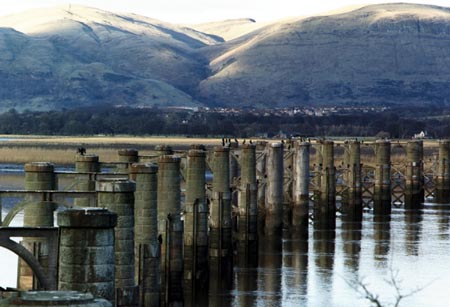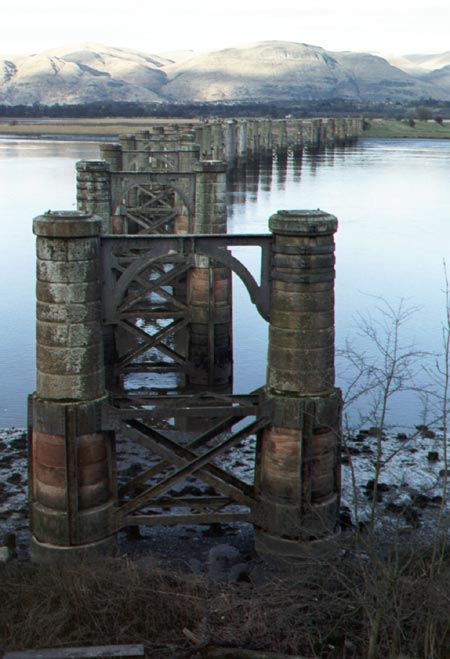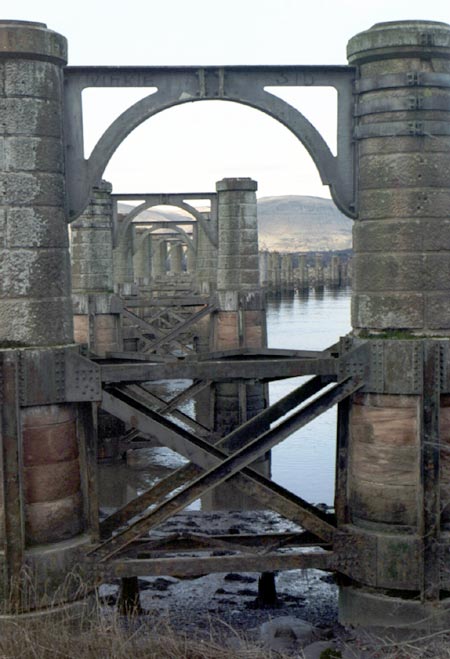

ALLOA RAILWAY SWING BRIDGE AT THROSK, STIRLINGSHIRE
and Bandeath Admiralty pier
 |
 |
|---|---|
| There are few sights on the Forth as spectacular as the forty stone and riveted iron plate columns of the Alloa swing bridge, standing 24ft above HW springs, yet so little known. Sometimes referred to as “The other Forth railway bridge” it was completed in 1885 and carried regular services until 1968. The Alloa railway was double track but the bridge only carried single track (1 & 2). The swing section was moved by a steam engine to allow shipping to pass and carried a signal box on girders above the track. In 1971 the central swinging portion was removed and later the track and spans that approached it, leaving just the piers. The line was finally closed in 1978 together with the former Admiralty munitions depot at Bandeath, now an industrial estate, which was served by it. | |
 |
 |
My first sight of the bridge was on going up river to Bandeath. Whilst the scale of the bridge piers is imposing, when closing the structure on the flood tide the difference in water level either side of the columns as the water pours past cannot fail to impress. The columns are braced together in pairs with cast iron brackets to stiffen the structure and spread the force of the current. However steerage way plus river current takes one past so quickly it is difficult to take in all the detail. The helmsman certainly has other concerns but by having a camera ready to hand in the cockpit I could take a few quick frames as the boat raced past.
Although the bridge is close to the main Throsk to Stirling road the site is hidden by trees and the track bed of the former railway, though passable on foot, is a bit over-grown. It is visited by locals and railway buffs who can find it with a 1:50,000 OS map. The brick built abutments remain and the ends have been walled across but one can look over and see the half mile curve of piers across the river.
The area is one of lush farm land and like the upper Tay the reed beds are a haven for wildlife. At Throsk this almost hidden valley is prime duck country and the bridge columns a safe roost for numerous cormorants that stand wings spread, drying in the sun (3).
The yachtsman can be thankful that when the Alloa bridge was closed the spans were removed as otherwise they would have been a barrier to masts. The now fixed Kincardine bridge is the obstruction to greater use of these waters by yachtsmen, necessitating passage under the bridge at low water springs and then waiting for water to go further up river. The delay both ways deters most visitors but maintains this tranquil scene with backdrop of the Ochils, so different from the lower Forth estuary. The enforced wait at Kincardine has value, time to check your mast head clearance calculations, relax and watch the herons.
The Bandeath munitions depot pier at the next bend in the river has a railway mounted crane sitting on a pair of standard gauge rails. The res t of the rails on the pier have been removed. The pier is privately owned and in a ruinous condition. It is advisable to keep well clear. Although a largely timber construction it is reinforced with massive rolled steel joist horizontals but the deck is thoroughly rotten, in places entirely missing and the ladders not to be trusted. The suggestion has been made to Stirling Council that the crane be removed lest it slide into the river, create a hazard to navigation and affect their plans for river boat excursions.
Anchoring midstream is the best way to take in the scene. There is next to no traffic and the river bed gives good holding. Traffic however is likely to increase following the Riverside development at Stirling . From Bandeath puffers were used to ferry shells and torpedoes down to the fleet through two world wars. Puffers were so called because their boilers lacked condensers, resulting in an escaping puff of steam with every thrust stroke of the final stage piston (4).
The depot is a large area of well separated warehouses; each surrounded by its own earth blast wall and served by an internal railway. The Luftwaffe carried out aerial reconnaissance and knew what they were looking at, marking their photograph Munitionslager (Torpedolager?) (5). This photograph also shows the swing bridge and is reproduced by kind permission of the Royal Commission for Ancient and Historical Monuments of Scotland .
The Bandeath industrial estate is accessible by car. It looks much the same as in its Admiralty days and gives an impression of the logistics of keeping the Grand Fleet supplied. Much rail has been removed but here and there it peeps through the turf. A gap in the palisade fence gives access to the pier but it is advisable to keep off it. One can venture onto the pier if one only steps on the beams underneath the decking but it is hardly worth the risk. A long lens will get you photographs without setting foot on the pier and the interior of the crane has been stripped. To move the crane would require relaying rails. Why it was marooned on the pier who knows?
Following the liquidation of Westerly Yachts, in 2001-2 there was an attempt to build some of the smaller designs in one of the industrial units at Bandeath but the venture foundered. The moulds can still be seen on the estate. The river was not used, the two yachts built were moved by road but consideration had been given to launching from the site and remained a possibility.
The return down river gives one another view of the scene which is fortunate as there is so much to see. Different shadow cast helps one pick out more reed bed detail. When construction of the new Forth road crossing begins there may be a general rediscovery of the remarkable Alloa swing bridge and the beauty of the area. To judge from the interest in my boat from the riverbank and dire warnings from onlookers, leisure boaters are infrequent users of this stretch of the river. With normal caution and planning, taken on the flood, avoiding the area when the river is in spate, it is a pleasing trip with a difference. References 1. Alloa Railway, www.railscot.co.uk/Alloa_Railway/body.htm 2. The Railways of Fife , William Scott Bruce, Melven P res s, Perth . 1980. ISBN 0 906664 03 9. 3. Forth Area Bird Report published in the Forth Naturalist and Historian, available from The Library, University of Stirling . http://www.the-soc.fsnet.co.uk/forth-recorder.htm 4. The Clyde Puffer, Dan McDonald, David and Charles, 1977, ISBN 0-7153-7443-5. 5. Catalogue of the Luftwaffe Photographs in the National Monuments Record of Scotland . Scotland from the Air 1939-45. Volume I. http://www.rcahms.gov.uk/
Paul Shave, yacht Blue Spindrift
|
|
©dss2006
info@fyca.org.uk
ędss2016